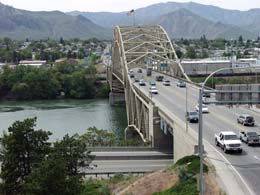On October 28, 1950, the second highway bridge across the Columbia River at Wenatchee opens. The crossing replaces a bridge built in 1908, which was the first highway bridge to span the Columbia (and which will remain in use as a footbridge). The new bridge, a steel cantilever bridge with a steel arch, is built downriver from the historic old highway bridge. The American Institute of Steel Construction gives it an award as the most beautiful bridge in its class built in 1950. The bridge carries U.S. Highway 2, also designated Primary State Highway 2 (later State Route 2) across the Columbia.
Unique for its Era
The bridge connected the cities of Wenatchee and East Wenatchee. It cost $1,853,684 to build, and had a total length of 1,208 feet, with a 54-foot-wide roadway and a five-foot sidewalk on either side.
In 1995 the bridge was described in a form nominating it to be listed on the National Register of Historic Places:
"The design of the steel spans, including a suspended tied arch, was unique for this era and appears to be the first of its type to have been built on the state highway system. The structural steel portion of the bridge consists of a main span of 480 feet, with anchor arms of 224 feet. The main span includes a suspended span of 352 feet in length and two cantilever spans each being 64 feet long" (National Register of Historic Places Registration Form).
The spans were tied to a through-arch steel truss. A through arch is one the traffic drives through -- the supporting truss is both under the roadway and overhead. In a through-arch bridge the deck is "tied" to, i.e., suspended from, the arch. The steel-truss arch rose 66 feet above the roadway and 180 feet above the Columbia River.
The bridge was built by the General Construction Company of Seattle and its structural steel was fabricated by American Bridge, a division of the U.S. Steel Corporation of Gary, Indiana. The bridge engineer was R. W. Fincke. The year it opened the American Institute of Steel Construction awarded it the National Competitive Award as the most beautiful built that year in its class, which was "bridges with one or more spans over 400 feet in length" (First Biennial Report, 1950-1952).
The bridge carried U.S. 2 until 1975, when a new bridge was built for that highway. Two years later, the 1950 bridge was returned to the state highway system and designated part of SR 285. In 1995 that SR 285 bridge was listed on the National Register of Historic Places, and in 2000 it was named the Senator George Sellar Bridge in honor of a state senator.

